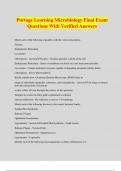Archaeons Study guides, Class notes & Summaries
Looking for the best study guides, study notes and summaries about Archaeons? On this page you'll find 57 study documents about Archaeons.
Page 2 out of 57 results
Sort by

-
Portage Learning Microbiology Exam #1 Latest 2024 Already Passed
- Exam (elaborations) • 4 pages • 2024
- Available in package deal
-
- $10.49
- + learn more
Portage Learning Microbiology Exam #1 Latest 2024 Already Passed Microorganism - Answer ️️ -Single cell (bacteria, archaeons, fungi, protozoa, algae) Virus - Answer ️️ -Not living, not considered microorganisms, considered microbes Microbes - Answer ️️ -Include microorganisms and viruses, can be advantageous or harmful Cell - Answer ️️ -Smallest, most basic biological unit of life All cells are compromised of - Answer ️️ -Macromolecules (building bloacks) Four main typ...

-
Portage Learning Microbiology Final Exam Questions With Verified Answers
- Exam (elaborations) • 6 pages • 2024
-
- $11.49
- + learn more
Portage Learning Microbiology Final Exam Questions With Verified Answers Match each of the following organelles with the correct description. Nucleus Endoplasmic Reticulum Lysosomes Chloroplasts - answerNucleus - Contains genomic content of the cell Endoplasmic Reticulum - Series of membrane-enclosed sacs and interconnected tubes Lysosomes - Contain hydrolytic enzymes capable of degrading unwanted cellular debris Chloroplasts - Site of photosynthesis Briefly explain how a Scanning Elec...

-
BIOD 171 Microbiology Module 1 – 6 Exam Questions and Answers
- Exam (elaborations) • 39 pages • 2024
- Available in package deal
-
- $13.49
- + learn more
BIOD 171 Microbiology Module 1 – 6 Exam Questions and Answers Microbiology -Answer-The study of microbes and their biological processes at the micro (microscopic) level. Microbes -Answer-1. A general term that includes microorganisms and viruses; an organism or virus too small to be seen without a microscope 2. Beneficial when aiding in food digestion to protecting us when we are exposed to potentially harmful foreign invaders to helping crops grow 3. Detrimental when harmful strains o...

-
Portage Learning Microbiology Final Exam Questions With Verified Answers
- Exam (elaborations) • 6 pages • 2024
-
- $11.49
- + learn more
Portage Learning Microbiology Final Exam Questions With Verified Answers Match each of the following organelles with the correct description. Nucleus Endoplasmic Reticulum Lysosomes Chloroplasts - answerNucleus - Contains genomic content of the cell Endoplasmic Reticulum - Series of membrane-enclosed sacs and interconnected tubes Lysosomes - Contain hydrolytic enzymes capable of degrading unwanted cellular debris Chloroplasts - Site of photosynthesis Briefly explain how a Scanning Elec...

-
Portage Learning Microbiology Exam #1 |Questions with 100% Correct Answers | Updated & Verified | 2024
- Exam (elaborations) • 8 pages • 2024
- Available in package deal
-
- $9.99
- + learn more
Microorganism - Single cell (bacteria, archaeons, fungi, protozoa, algae) Virus - Not living, not considered microorganisms, considered microbes

-
Portage Learning Microbiology Final Exam Questions with Complete Solutions
- Exam (elaborations) • 6 pages • 2023
- Available in package deal
-
- $13.49
- + learn more
Match each of the following organelles with the correct description. Nucleus Endoplasmic Reticulum Lysosomes Chloroplasts - Nucleus - Contains genomic content of the cell Endoplasmic Reticulum - Series of membrane-enclosed sacs and interconnected tubes Lysosomes - Contain hydrolytic enzymes capable of degrading unwanted cellular debris Chloroplasts - Site of photosynthesis Briefly explain how a Scanning Electron Microscope (SEM) forms an image of subcellular organelles, substrates,...

-
Portage Learning Microbiology Final Exam Questions With 100% Correct Answers.
- Exam (elaborations) • 5 pages • 2023
-
- $10.49
- + learn more
Portage Learning Microbiology Final Exam Questions With 100% Correct Answers. Match each of the following organelles with the correct description. Nucleus Endoplasmic Reticulum Lysosomes Chloroplasts Answer - Nucleus - Contains genomic content of the cell Endoplasmic Reticulum - Series of membrane-enclosed sacs and interconnected tubes Lysosomes - Contain hydrolytic enzymes capable of degrading unwanted cellular debris Chloroplasts - Site of photosynthesis Briefly explain how a Scan...

-
Portage Learning Microbiology Exam #1 with 100% correct answers
- Exam (elaborations) • 17 pages • 2023
- Available in package deal
-
- $8.99
- + learn more
Microorganism Single cell (bacteria, archaeons, fungi, protozoa, algae) Virus Not living, not considered microorganisms, considered microbes 00:13 01:42 Microbes Include microorganisms and viruses, can be advantageous or harmful Cell Smallest, most basic biological unit of life All cells are compromised of Macromolecules (building bloacks) Four main types of macromolecules found ing cells Proteins, nucleic acids, lipids, and polysaccharides ...

-
BIOS 1300 - Ohio University exam study guide with updates as late as 2023 graded A+
- Exam (elaborations) • 5 pages • 2023
- Available in package deal
-
- $11.99
- + learn more
BIOS 1300 - Ohio University exam study guide with updates as late as 2023 graded A+ nucleic acids - store and transmit information needed for growth, function, and reproduction features of a cell - 1. store and transmit info to reproduce 2. plasma membrane 3. ability to harness energy from the environment Virtually every aspect of the cell's existence—its internal architecture, its shape, its ability to move, and its various chemical reactions—depends on - proteins Transcr...

-
Portage Learning Microbiology Exam #1 2023 with 100% correct answers
- Exam (elaborations) • 6 pages • 2023
-
- $13.49
- + learn more
Microorganism Single cell (bacteria, archaeons, fungi, protozoa, algae) Virus Not living, not considered microorganisms, considered microbes Microbes Include microorganisms and viruses, can be advantageous or harmful Cell Smallest, most basic biological unit of life All cells are compromised of Macromolecules (building bloacks) Four main types of macromolecules found ing cells Proteins, nucleic acids, lipids, and polysaccharides Proteins Comprised...

$6.50 for your textbook summary multiplied by 100 fellow students... Do the math: that's a lot of money! Don't be a thief of your own wallet and start uploading yours now. Discover all about earning on Stuvia


